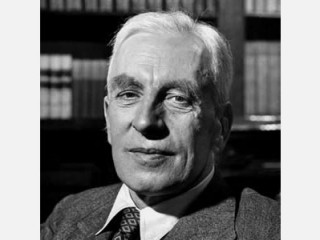
Arnold Toynbee biography
Date of birth : 1889-04-14
Date of death : 1975-10-22
Birthplace : London, England
Nationality : British
Category : Famous Figures
Last modified : 2010-12-21
Credited as : Historian, and philosopher,
The English historian and philosopher of history Arnold Joseph Toynbee described himself as a "metahistorian" whose "intelligible field of study" was civilization.
Arnold Toynbee was born into an upper-middle-class family. He attended Balliol College, Oxford, and from 1912 to 1915 he was a fellow and tutor in classics. During World War I he served in the Political Intelligence Department of the War Office, where, among other duties, he edited accounts of atrocities. In 1919 he was a member of the Middle Eastern section of the British delegation to the Paris Peace Conference.
He was Koraes professor of Byzantine and modern Greek language, literature, and history at London University from 1919 to 1924. From 1925 until he retired in 1955 he was director of studies in the Royal Institute of International Affairs and professor of international history at London University. He directed the Research Department at the Foreign Office from 1943 until 1946, when he attended the Paris Peace Conference as a British delegate.
The horror of World War I turned Toynbee's conception of his lifework away from the narrow national scholarship in which he had been trained. Struck with parallels between Greco-Roman civilization and his own time, he projected in 1921 a comparative and comprehensive study of the world's civilizations. But between 1921 and 1934, when the first three volumes of the massive Study of History appeared, Toynbee wrote more than 140 articles and books, mostly in the orthodox tradition which he had decided to transcend. These included The Western Question in Greece and Turkey (1922), Greek Historical Thought (1924), Greek Civilisation and Character (1924), the carefully documented Survey of International Affairs (1923-1927), and A Journey to China (1931); furthermore, he edited British Commonwealth Relations (1934).
The second three volumes of Toynbee's Study were published in 1939; four more in 1954; an atlas in 1959; and in 1961 a final volume, Reconsiderations, which attempted to answer his critics. The first 10 volumes traced a pattern modeled upon Toynbee's Hellenic studies. Isolating 23 complete civilizations, and arguing that his conclusions were deduced from empirical evidence, he described parallel life cycles of growth, dissolution, a "time of troubles, " a universal state, and a final collapse leading to a new genesis. Although he found the uniformity of the patterns, particularly of disintegration, sufficiently regular to reduce to graphs, and even though he formulated definite laws of development such as "challenge and response, " Toynbee insisted that the cyclical pattern could, and should, be broken.
Beginning in 1954 his cyclical emphasis yielded to a progressive view of history supported first by Christian millennialism and then by a combination of "higher" religions moving toward a synthesis of nations beyond the failures of past civilizations. In Reconsiderations he altered his count of civilizations to 28, including 13 "independent" and 15 "satellite, " and he abandoned his Hellenic model and Western civilization as destructively neopagan and egocentric.
In the 1950s, Toynbee concerned himself increasingly with religion as the means to world unity. In An Historian's Approach to Religion (1956) he urged that we "wrench ourselves" out of the "mathematico-physical line of approach which we are still following" to "make a fresh start from the spiritual side." In Change and Habit: The Challenge of Our Time (1966) he predicted that if the United States and the Soviet Union do not agree to maintain world order, China, whose religious and historical traditions attracted Toynbee, may emerge as the "world-unifier." Even when treating world affairs, he turned eventually from the disquieting realities of history to the greater security of a metaphysics beyond history.
Two of Toynbee's later works included Cities on the Move (1970), and Constantine Porphyrogenitus and His World (1973). Toynbee died in York, England, on Oct. 22, 1975.
Edward T. Gargan edited a series of major criticisms in The Intent of Toynbee's History: A Cooperative Appraisal (1961), with a preface by Toynbee. Pieter Geyl republished his critiques in Debates with Historians (1958). Various aspects of Toynbee's thought are summarized in Pitirim A. Sorokin, Social Prophecies of an Age of Crisis (1950); Jacobus G. De Beus, The Future of the West (1953); and Warren W. Wagar, The City of Man: Prophecies of a World Civilization in Twentieth-century Thought (1963).
















